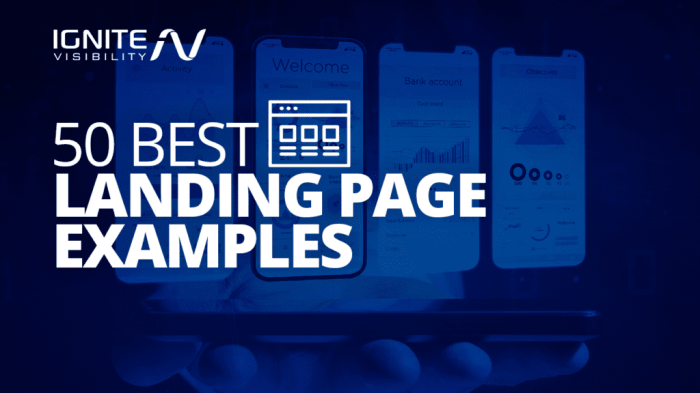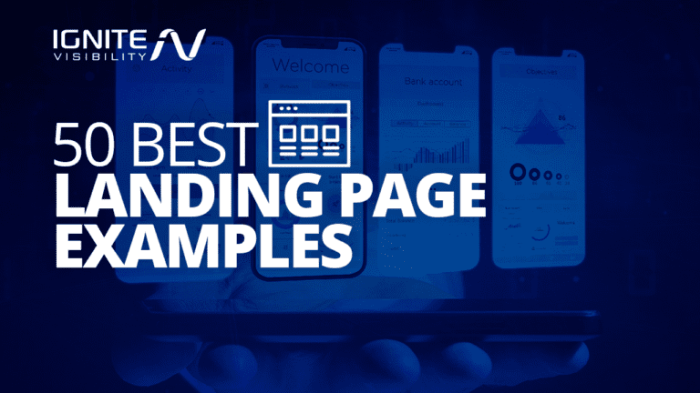Effective Landing Pages set the stage for successful online marketing campaigns, driving conversions with compelling content and design elements that captivate visitors from the get-go. Dive into the world of high-converting landing pages where creativity meets strategy for maximum impact.
Importance of Effective Landing Pages
Landing pages play a crucial role in online marketing campaigns by serving as the first point of contact between a user and a website. A well-designed landing page can make a significant impact on conversion rates, positively influencing the success of a marketing campaign. Additionally, landing pages are essential in improving user experience and engagement, providing visitors with relevant information and guiding them towards the desired action.
Impact on Conversion Rates
A well-crafted landing page with clear and compelling call-to-action buttons can lead to higher conversion rates. By focusing on a specific product or service and eliminating distractions, landing pages can effectively drive visitors to take the desired action, whether it’s making a purchase, signing up for a newsletter, or requesting more information.
Improving User Experience and Engagement
Landing pages are designed to provide a seamless and intuitive user experience, making it easy for visitors to find the information they are looking for and take action. By optimizing landing pages for speed, mobile responsiveness, and relevance, businesses can enhance user engagement and encourage repeat visits.
Key Elements of an Effective Landing Page

When it comes to creating a successful landing page, there are several key elements that can make a significant impact on the overall effectiveness of your page. From a compelling headline to relevant imagery, each component plays a crucial role in driving conversions and engaging visitors.
Compelling Headline
A compelling headline is the first thing visitors see when they land on your page. It should be clear, concise, and attention-grabbing, instantly conveying the value proposition of your offer. A well-crafted headline can pique the interest of visitors and entice them to explore further.
Clear Call-to-Action
A clear call-to-action (CTA) is essential for guiding visitors towards the desired action, whether it’s making a purchase, signing up for a newsletter, or downloading a resource. The CTA should be prominent, visually appealing, and clearly communicate what visitors need to do next.
Relevant Imagery
Incorporating relevant imagery can enhance the visual appeal of your landing page and help reinforce your message. High-quality images that align with your brand and resonate with your target audience can increase engagement and create a more memorable user experience.
Mobile-Responsive Design
With the increasing use of mobile devices, having a mobile-responsive design is crucial for ensuring that your landing page looks and functions seamlessly across all devices. A responsive design allows visitors to easily navigate your page on smartphones and tablets, improving user experience and reducing bounce rates.
Social Proof and Testimonials, Effective Landing Pages
Including social proof, testimonials, or trust indicators on your landing page can help build credibility and trust with visitors. Testimonials from satisfied customers, client logos, or statistics can help reassure potential customers and encourage them to take the desired action.
Overall, by incorporating these key elements into your landing page, you can create a more impactful and conversion-driven experience for your visitors.
Design Best Practices for Landing Pages

When it comes to designing effective landing pages, it’s important to create a visually appealing layout that captures visitors’ attention and keeps them engaged. By following some key design best practices, you can ensure that your landing page not only looks great but also drives conversions.
Using Color Schemes, Fonts, and White Space
To create a visually appealing landing page, it’s essential to use color schemes, fonts, and white space effectively. Here are some tips to keep in mind:
- Choose a color scheme that aligns with your brand and evokes the right emotions. Use contrasting colors for call-to-action buttons to make them stand out.
- Select fonts that are easy to read and consistent with your brand’s tone. Avoid using too many different fonts, as this can make your page look cluttered.
- Utilize white space strategically to create a clean and organized layout. White space helps to guide visitors’ attention to key elements on the page.
Optimizing Images and Content for Speed
The loading time of your landing page can significantly impact user experience and conversions. Here are some ways to optimize images and content for speed:
- Compress images to reduce file sizes without compromising quality. Use image formats like JPEG or PNG for web use.
- Avoid using large, high-resolution images that can slow down your page load times. Opt for optimized images that still look great but load quickly.
- Minimize the use of plugins and scripts that can increase page load times. Keep your code clean and efficient to ensure fast loading speeds.
Optimizing Landing Pages for Conversions
To increase conversions on landing pages, it is essential to continuously optimize and test various elements to maximize performance. A successful conversion optimization strategy involves A/B testing, tracking key metrics, and implementing personalized content or offers.
A/B Testing for Improved Performance
A/B testing involves creating two versions of a landing page with slight variations in elements such as headlines, images, call-to-action buttons, or form fields. By presenting these versions to different segments of your audience and analyzing the results, you can identify which elements drive better conversion rates. This iterative process helps in refining the landing page to enhance its effectiveness.
- Test one element at a time to accurately determine its impact on conversions.
- Use tools like Google Optimize or Optimizely to conduct A/B tests efficiently.
- Monitor metrics such as conversion rate, bounce rate, and click-through rate to evaluate the performance of different variations.
Importance of Tracking Key Metrics
Tracking metrics like bounce rate, click-through rate, and conversion rate is crucial in understanding how visitors interact with your landing page. These metrics provide valuable insights into user behavior and help in identifying areas for improvement.
- Bounce Rate: Indicates the percentage of visitors who leave the landing page without taking any action. A high bounce rate may suggest that the page is not engaging enough.
- Click-Through Rate: Measures the percentage of visitors who click on a specific element, such as a call-to-action button. A low click-through rate may indicate a need for optimization.
- Conversion Rate: Represents the percentage of visitors who complete the desired action, such as making a purchase or filling out a form. Tracking conversion rate helps in evaluating the overall effectiveness of the landing page.
Implementing Personalized Content or Offers
Personalizing the content or offers on your landing page can significantly impact conversions by making the visitor feel more engaged and valued. By tailoring the messaging or incentives based on visitor behavior or demographics, you can create a more personalized experience that resonates with the audience.
- Use dynamic content to display personalized recommendations or messages based on the visitor’s previous interactions.
- Create targeted offers or discounts for specific audience segments to increase the likelihood of conversion.
- Implement interactive elements like quizzes or surveys to gather data and deliver customized content accordingly.